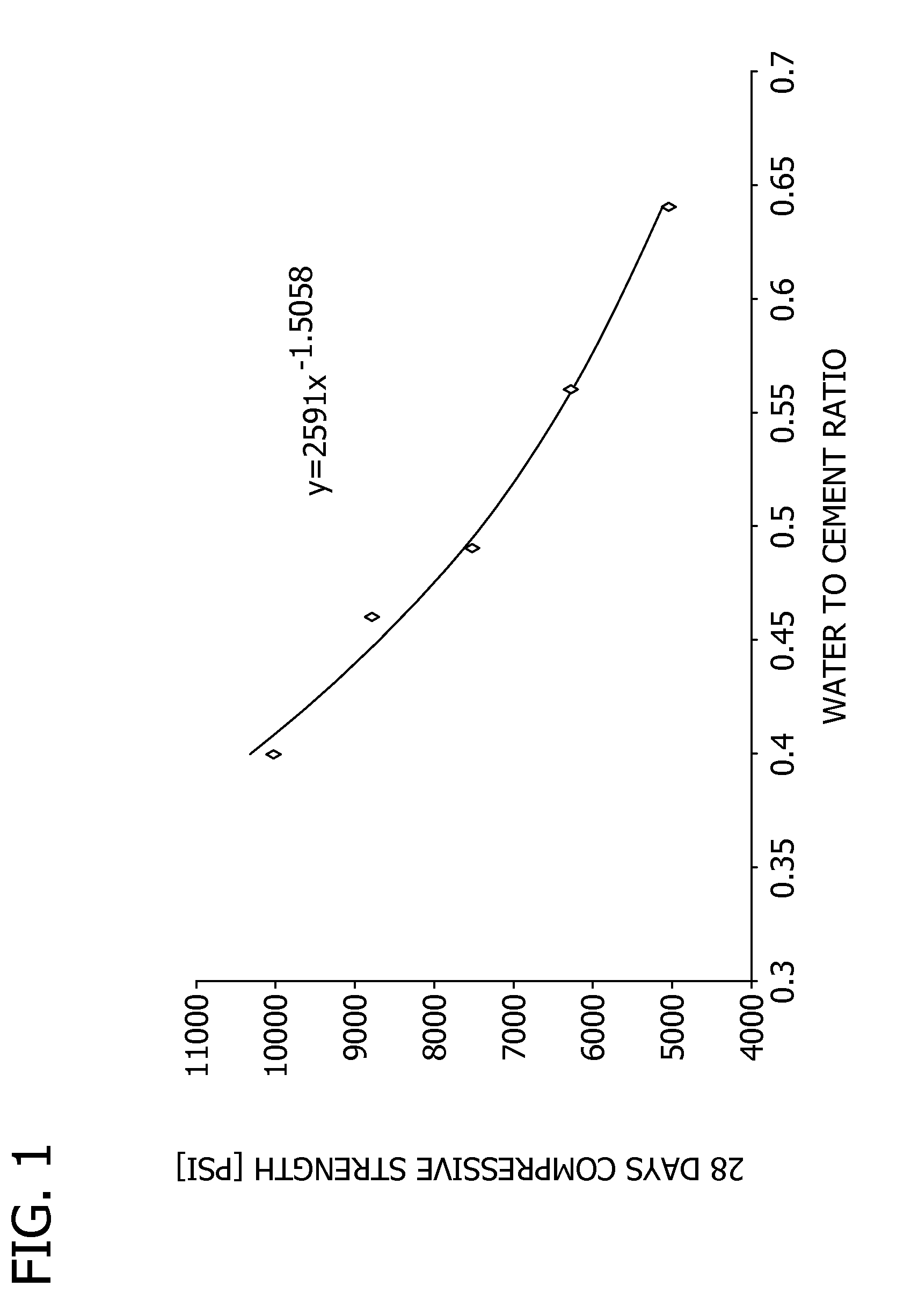Method of designing a concrete compositions having desired slump with minimal water and plasticizer
a technology of concrete composition and minimal water, applied in the field of design optimization of concrete compositions, can solve the problems of fundamental disconnect between requirements, controls and limitations, and experts do not typically prepare concrete compositions at concrete plants for delivery to customers
- Summary
- Abstract
- Description
- Claims
- Application Information
AI Technical Summary
Benefits of technology
Problems solved by technology
Method used
Image
Examples
example 1
[0119]In this Example, a concrete design mix was optimized to yield target compressive strength and a target slump amount with a minimal amount of water and cement. More particularly, six setup mix designs were designed and the water to cement ratios were determined for producing strengths and slumps in the desired or targeted range (e.g., 3,000 psi, 4,000 psi, 5,000 psi, and 6,000 psi).
[0120]To begin, an existing manufacturer provided a manufacturer's material supply statement that included a cement data sheet, a sieve analysis, and surface-saturated-dry specific gravity and absorption data for both sand and rock aggregates. Six sample mixes were then designed using the manufacturer's mix designs corresponding to more than 80% of their sales volume and using representing water content (i.e., the present amount of water used by manufacturer) and water to cement ratios to cover the target range of strengths. In this case, water contents of: 258, 254, 254, 250, 238, and 265 were chose...
example 2
[0129]In this Example, a fingerprint curve was generated for a particular concrete manufacturing plant using the computer-implemented methods as described herein.
[0130]Specifically, all materials and properties data of the materials from the manufacturing plant were received and entered into a computer in a laboratory. An approximately 5500 PSI concrete mix design (w / c=0.608) was then designed using the fingerprint curve of FIG. 1 with the equation:
28-day strength=2591×w / c−1.5058
Based on previous mix designs from the manufacturing plant, the first mix design for a water demand test was produced as shown in Table 4.
TABLE 4Amount of Component inMix Design (lbs / yd3)Cement476Class F Fly Ash143Manufactured Sand1641¾” Rock1284Water279
[0131]While mixing the components in the laboratory to produce the concrete compositions, additional water, providing a final water demand of 295 lbs / yd3, had to be added in order to achieve a 2″ slump.
[0132]Additional mix designs were produced for: (1) w / c=...
example 3
[0133]In this Example, a fingerprint curve was generated for a particular concrete manufacturing plant using the computer-implemented methods as described herein.
[0134]Specifically, all materials and properties data of the materials from the manufacturing plant were received and entered into a computer in a laboratory. An approximately 5500 PSI concrete mix design (w / c=0.608) was then designed using the fingerprint curve of FIG. 1 with the equation:
28-day strength=2591×w / c−1.5058
Based on previous mix designs from the manufacturing plant, the first mix design for a water demand test was produced as shown in Table 5.
TABLE 5Amount of Component inMix Design (lbs / yd3)Cement411Class F Fly Ash123Manufactured Sand709Natural Sand1056¾” Rock1450Water254
[0135]While mixing the components in the laboratory to produce the concrete compositions, additional water, providing a final water demand of 275 lbs / yd3, had to be added in order to achieve a 2″ slump.
[0136]Additional mix designs were produce...
PUM
| Property | Measurement | Unit |
|---|---|---|
| Fraction | aaaaa | aaaaa |
| Fraction | aaaaa | aaaaa |
| Compressive strength | aaaaa | aaaaa |
Abstract
Description
Claims
Application Information
 Login to View More
Login to View More - R&D
- Intellectual Property
- Life Sciences
- Materials
- Tech Scout
- Unparalleled Data Quality
- Higher Quality Content
- 60% Fewer Hallucinations
Browse by: Latest US Patents, China's latest patents, Technical Efficacy Thesaurus, Application Domain, Technology Topic, Popular Technical Reports.
© 2025 PatSnap. All rights reserved.Legal|Privacy policy|Modern Slavery Act Transparency Statement|Sitemap|About US| Contact US: help@patsnap.com



